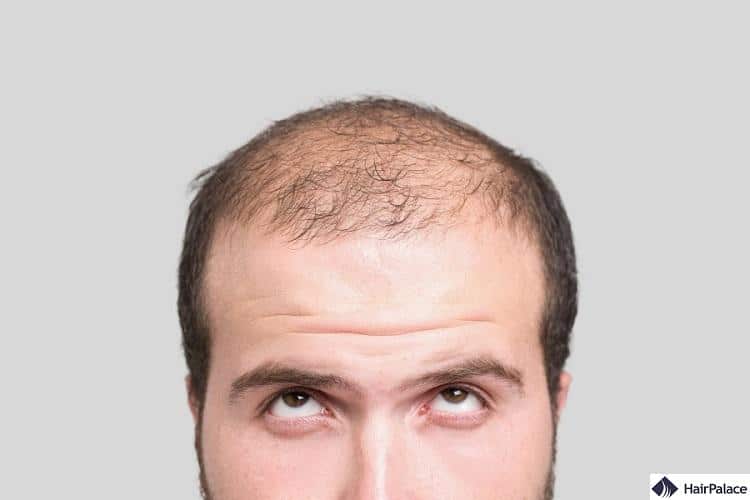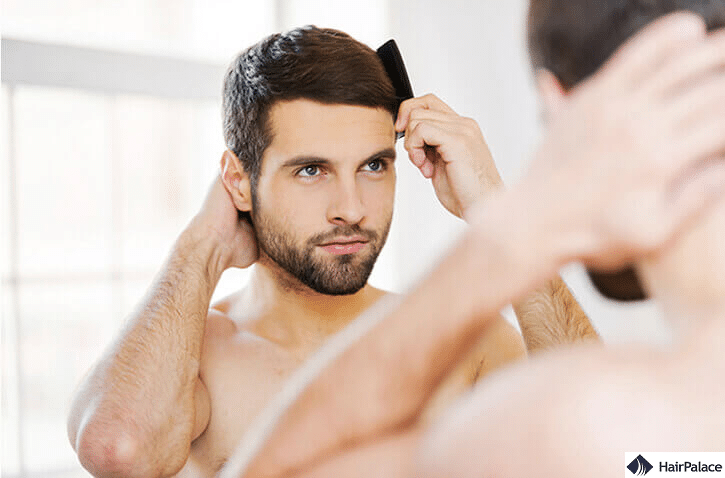Does Wearing a Hat Cause Hair Loss?

Hats are a great way to add to our style and they also have a lot of practical uses.
While wearing hats may seem harmless at first, you may risk the health of your hair strands by overusing these garments.
While wearing hats may seem harmless at first, you may risk the health of your hair strands by overusing these garments.
But is there really a connection between hair thinning and wearing a hat?
Let’s see what researchers say about hats and hair loss!
- Do hats cause hair loss?
- What the research says
- Treatment options
- Other causes
- Prevention
- Conclusion
Do hats cause hair loss?
Wearing a hat alone does not directly cause hair loss. However, if you wear hats that are too tight and cause friction or pull on your hair, it can lead to hair damage or breakage or hair loss over time. This is known as traction alopecia.
Additionally, if you wear a hat for extended periods of time and do not allow your scalp to breathe, it can lead to a buildup of sweat and oil.
This can clog hair follicles, and decrease blood flow which can prevent new hair from growing.
It is important to choose hats that fit properly and are not too tight and to avoid wearing hats for extended periods of time without taking breaks to allow your scalp to breathe.
What does the research say?
A study published in 2013 explored the relationship between different environmental factors (such as wearing a hat) and hair loss in 92 identical twins.
The study found that identical twins who wore a hat were less likely to lose hair in the area that was covered than twins who didn’t.
The study also made interesting revelations in terms of increased hair loss and:
- increased exercise duration
- excessive drinking
- more money spent on hair products
Despite the seemingly positive effects of wearing a hat on overall hair health, most doctors advise against wearing a hat that is too tight.
This is because tight hats may cause a decrease in blood flow to your hair follicles and lead to hair thinning.
This is referred to as traction alopecia, and while it is usually only temporary, it could become permanent if it persists for a longer period.
If you’re concerned about wearing a very tight hat, you should perhaps aim for a loose hat that allows your scalp to breathe.
8 possible ways to treat traction alopecia
Traction alopecia is a type of hair loss that occurs when hair is repeatedly pulled or under tension for extended periods.
Wearing hats can lead to this condition, but it may also be caused by a tight ponytail, braids, cornrows, or hair extensions.
These tight hairstyles pull on the hair and scalp and can lead to damaged hair follicles and a sudden onset of hair loss.
Here are some steps that can help treat traction alopecia:
1. Medication
Hair loss medications such as Minoxidil may help you regrow the hair you’ve lost due to traction alopecia.
This medication was originally developed for the treatment of high blood pressure, but doctors later discovered that it also has positive effects on stimulating hair growth.
2. Avoid tight hairstyles
The first step in treating traction alopecia is to avoid pulling hair and stay away from things such as tight ponytails or heavy hair extensions.
If you consistently wear your hair in such styles you may risk permanent hair loss, so choose looser styles instead of opting for a very tight ponytail.
3. Massage your scalp
Massaging your scalp can help improve circulation and make hair grow. Use your fingertips to gently massage your scalp in circular motions.
4. Apply essential oils
Certain hot oil treatments like lavender, rosemary, and peppermint have been shown to improve hair growth.
Mix a few drops of these oils with a carrier oil like coconut or jojoba oil and massage it into your scalp.
5. Use hair growth products
There are various hair growth products available that can help stimulate hair growth and help you sprout new hairs. Look for products that contain ingredients like biotin, keratin, and amino acids.
6. Take supplements
Certain supplements like biotin, iron, and vitamin D can help improve hair health and growth. Although it’s best to get professional medical advice before taking such supplements.
7. Give your hair a break
Avoid wearing tight hairstyles all the time. Give your hair a break by wearing looser styles or letting it rest. This will help reduce tension on the hair and scalp and give your hair time to recover.
8. Consult a dermatologist
If your hair loss is severe, consult a dermatologist. They can provide personalized treatment options, such as steroid injections or reconstructive surgery, to help regrow hair.
Hair restoration is often the best way to regain your lost hair.
7 most common causes of hair loss

As we age our hair naturally thins and becomes less dense but hair loss can be caused by a variety of factors. Here are some of the most common causes:
1. Genetics
Genetic hair loss is one of the most common causes of hair loss known as androgenetic alopecia or male pattern hair loss and female pattern baldness.
Male pattern baldness occurs slowly and causes gradual hair loss over time, what starts as a receding hairline can quickly escalate into widespread baldness across the scalp.
Male pattern baldness is so common that nearly all men will be affected by male alopecia at some point in their life.
2. Hormonal imbalances
Hormonal changes can also cause hair loss, such as during pregnancy, menopause, or thyroid disorders.
3. Medical conditions
Certain medical conditions, such as autoimmune disorders, scalp infections, and skin conditions, can cause hair loss.
4. Medications
Certain medications, such as chemotherapy drugs, can cause temporary hair loss.
5. Nutritional deficiencies
A lack of essential vitamins and minerals, such as iron, vitamin D, and biotin, can lead to hair loss.
6. Stress
Emotional or physical stress can cause hair loss, such as through a condition called telogen effluvium.
Although this condition tends to be temporary, as it doesn’t harm the hair follicle itself. Most patients experience hair regrowth without needing any treatment.
7. Hairstyles
Just like an extremely tight hat, a tight hairstyle that puts tension on the hair, such as tight braids or ponytails, can also cause hair loss over time.
It is important to speak with a healthcare professional if you are experiencing hair loss to determine the underlying cause and receive appropriate treatment.
9 tips to prevent hair loss

Although there is no conclusive evidence that suggests hats cause hair loss in men, it appears improbable.
Nonetheless, to be cautious, it is advisable to refrain from wearing excessively tight hats to avoid losing hair.
Since baldness is predominantly influenced by genetics, it may not be entirely preventable. However, you can take certain measures to prevent avoidable types of hair loss.
Here are some steps you can take to help prevent hair loss:
- Maintain a healthy diet: Eating a balanced diet rich in vitamins and minerals, such as iron, biotin, and vitamin D, can help keep hair healthy and prevent hair loss.
- Avoid tight hairstyles: Hairstyles that put tension on the hair, such as tight braids or ponytails, can cause hair loss over time.
- Avoid tight hats: Wearing such garments may cause you to experience traction alopecia. Stop wearing tight baseball caps and consider opting for a wide-brimmed hat instead.
- Handle hair gently: Be gentle when brushing, combing, or styling your hair to avoid damage or breakage. Use a wide-toothed comb whenever possible.
- Avoid heat styling: Overuse of heat styling tools such as flat irons, curling irons, and hair dryers can damage the hair and lead to hair loss.
- Manage stress: Emotional or physical stress can cause hair loss, so finding ways to manage stress, such as through meditation or exercise, can help prevent hair loss.
- Avoid harsh chemicals: Avoid using harsh chemicals on your hair, such as hair dyes or bleach, as they can damage the hair and lead to hair loss.
- See a healthcare professional: If you are experiencing hair loss, see a healthcare professional to determine the underlying cause and receive appropriate treatment.
- Take care of your scalp: Keeping your scalp clean and healthy can help prevent hair loss. Use a gentle shampoo and conditioner, and avoid using harsh products or over-washing your hair.
When to see a doctor
It’s generally a good idea to see a doctor if you are experiencing sudden or excessive hair loss or if you notice significant damage to your hair.
While there is no cure for conditions such as androgenic alopecia or alopecia areata, traction alopecia is easily preventable.
Overall, if you are concerned about your hair loss or hair damage, it’s a good idea to consult a doctor. They can help diagnose any underlying conditions and recommend appropriate treatments to address the issue.
Last medically reviewed on July 15th, 2024
- Gatherwright J, Liu MT, Amirlak B, Gliniak C, Totonchi A, Guyuron B. The contribution of endogenous and exogenous factors to male alopecia: a study of identical twins. Plast Reconstr Surg. 2013 May;131(5):794e-801e. doi: 10.1097/PRS.0b013e3182865ca9. PMID: 23629119.https://pubmed.ncbi.nlm.nih.gov/23629119/


